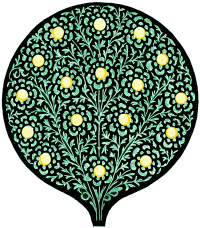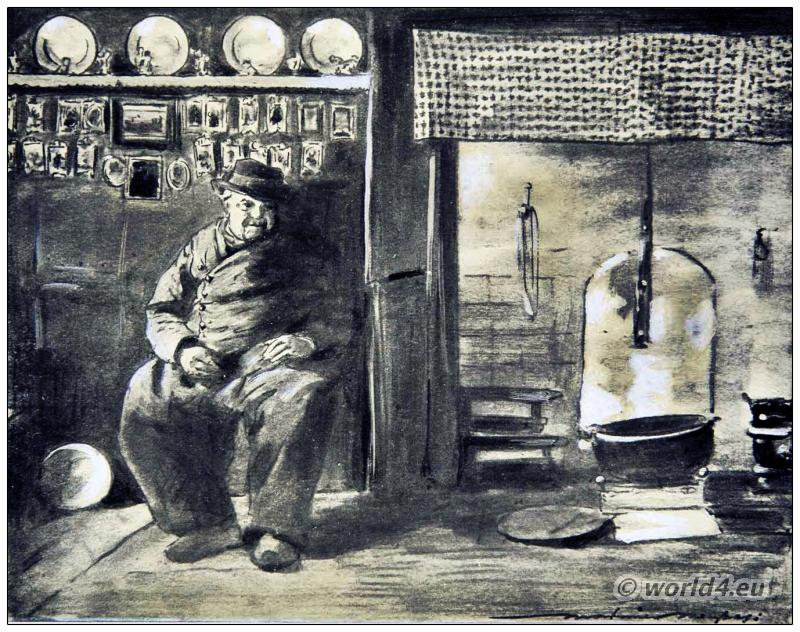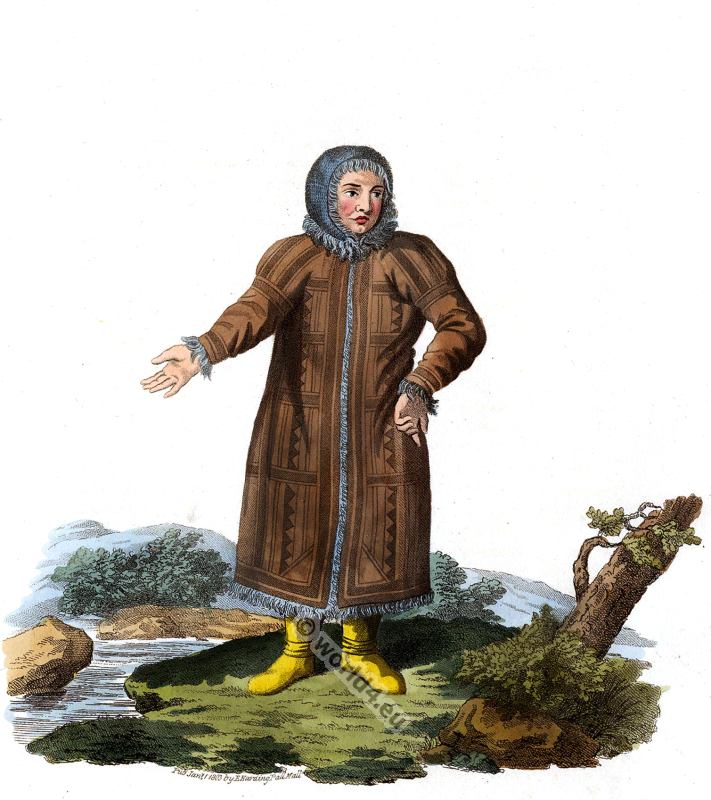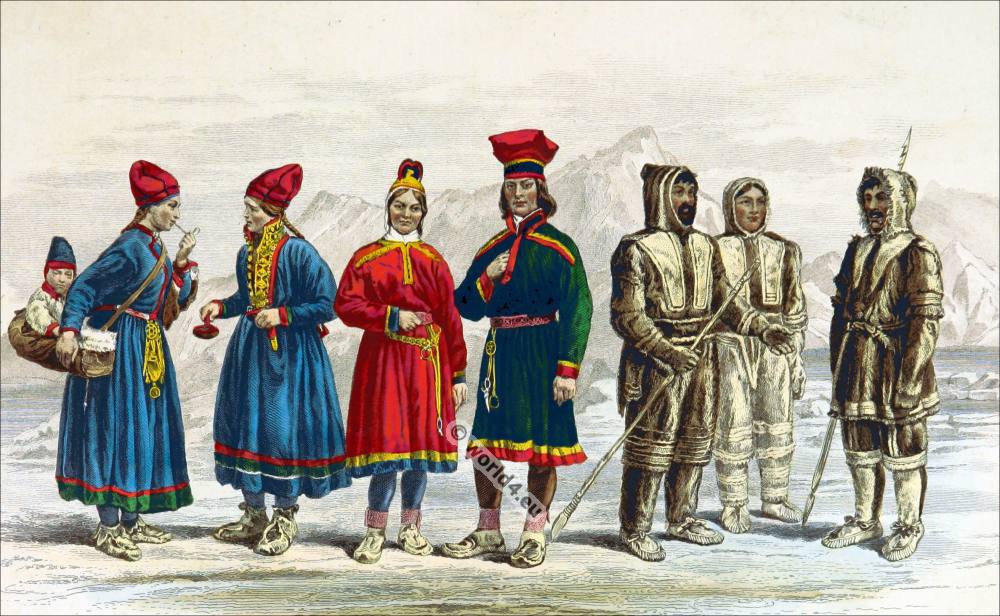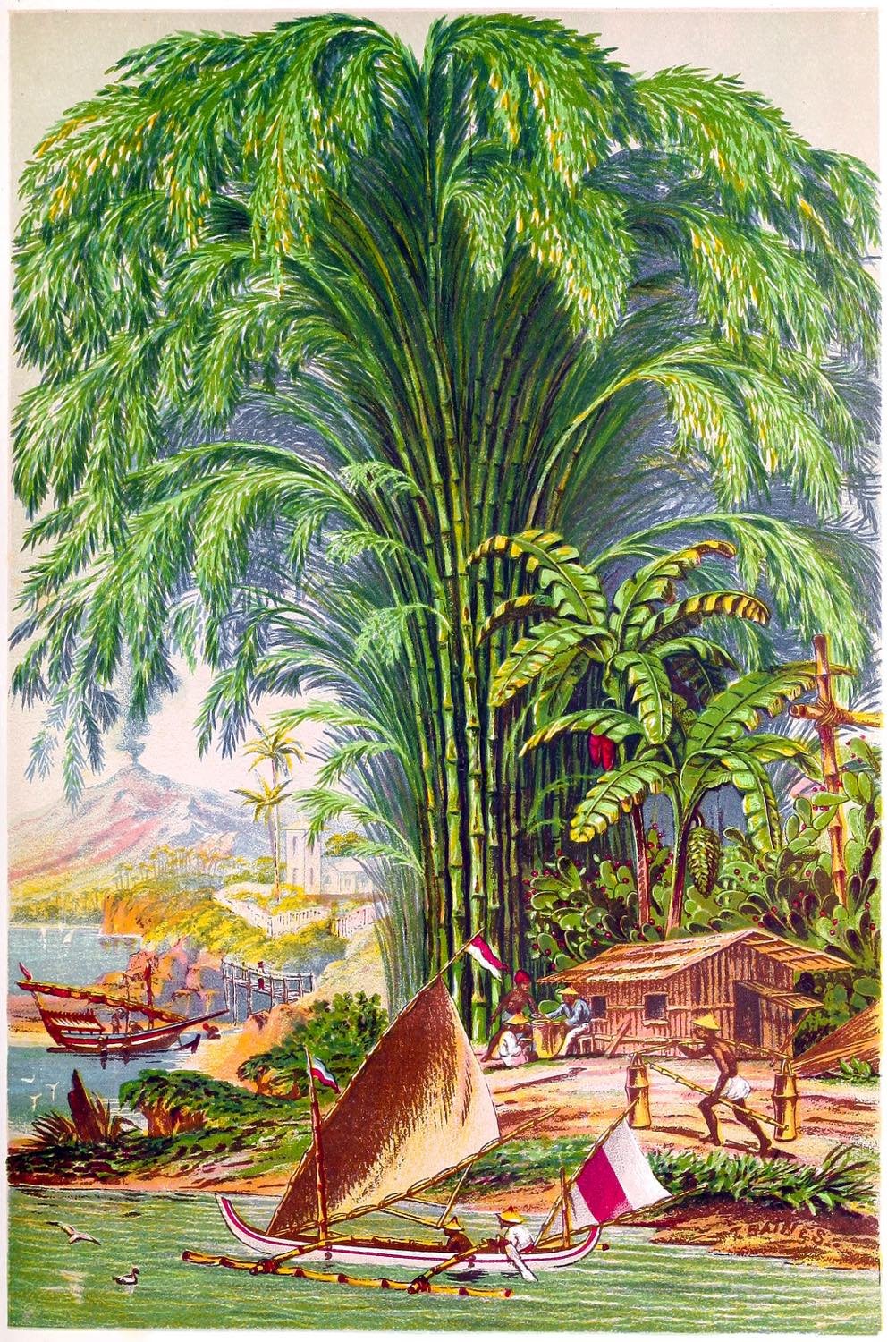
(Bambusa bambos, Bambusa arundinacea. Giant Thorney Bamboo)
The Bamboo Cane, its origin and traditional use.
By W. B. Lord, Royal Artillery. Nature and Art, October 1, 1866.
The Bamboo Cane.
IT would be difficult amongst all the treasures placed at man’s disposal by an all-wise Providence, to find one possessing so wide a field of use- fulness as that now under consideration. As there are sermons in stones, so are there discourses most eloquent inscribed on the ridged and furrowed bark, the spotted leaf, and amongst the waving grasses and trees of the forest, the ebbing and flowing tide, the drifting “gulf-weed,” and the branching coral; each tells its tale of wise provision to those who roam amongst the works of Nature, and faithfully study at her shrine.
From the frost-bound North, where the pigmy Esquimaux launches his skin canoe amongst the floes of floating ice, and captures the oil-bearing seal and fish — destined to furnish light, heat, and food through the long- twilight of an Arctic winter — to the prairies of the far West, where the mounted Indian hunter dashes in pursuit of the countless throngs of bison dotting the plains, Nature provides for man, as well as in other lands, where, under an ardent sun, lie requires more varied material with which to supply his daily wants and necessities. Our present object is to show how amply many of the most important requirements of those resident within, and on the borders of, the Torrid Zone *), are supplied by the gigantic grass, so wisely and profusely placed ready to their hands. Nothing can exceed in beauty the graceful bamboo, as its feathery foliage waves and flutters in the breeze. The color of its long, narrow, pointed leaves is charmingly refreshing, and the shade afforded by the natural canopies often formed by it is most enjoyable.
*) The Torrid is also known as the Tropics.
It will be observed, on examination, that the bamboos brought to this country for fishing-rods, walking-sticks, &c., are hollow, and that the hollows are divided at certain intervals by knots, or “internodes,” as they are called. These are produced by bundles of sap-bearing fibers, which are thrown across each other. They, like the rest of the interior, are lined with a soft white coating. From the outside borders of these knots are produced alternate lateral buds; and from these grow the alternate branchlets, which form of arrangement gives such elegance to the full-grown cane. No plant with which we are acquainted has anything like the rapidity of growth of the bamboo; it sometimes grows as much as four inches in one day. In favorable situations it has been known to shoot up twenty feet in height, and attain a circumference of from nine to ten inches in six weeks. Many natives, experienced in matters relating to cane, assert that every bamboo reaches its full altitude in one year from the time of its springing from the ground, and that the only change it afterwards undergoes is in the deposit of woody matter in its substance. It is very doubtful, however, as to whether this is the case, as many of the “topes,” or clumps of bamboo, which we have examined in Bengal, appear to be of considerable age, and of growth too irregular, even in the same clump, for all the shoots to have attained their full height at any given period, as light, space, and character of soil must all influence their development. Another notion prevails that in certain localities the cane will not bear seed until it is fifteen years old, after which it immediately dies.
Although growing wild over a vast extent of the East, the bamboo is at times carefully cultivated, and great pains are taken in its management. It is very singular, that although rich spongy soil is so congenial to its growth, continued moisture destroys it to a certainty. We had an opportunity of seeing this fully proved. A small rivulet, which had served to drain the superfluous water from a miniature lake in the woods, had been dammed back by a fallen tree; leaves, sticks, and dead water- plants had added their mass to the obstruction.
The lake had to find for itself a new outlet, which it did at the head of a valley on its border, converting that which was a bamboo thicket into a swamp. Every cane was soon dead, and standing stark and withered, whilst a thousand flowering plants and trailing creepers made haste to clothe them with their leaves and blossoms. So destructive to the bamboo is a too humid soil known to be, that a wide, deep trench is cut round each plantation, in order to carry off the water.
The bamboo is propagated from young sprouts, which are placed in pits about two feet deep, prepared for them at the close of the autumn months. As the season advances, and the young plants take root and shoot up, they are cut off close to the earth, in order to impart vigor to the parent root. And now comes into operation the art of the cane cultivator, who culls, assorts, and selects the particular plants he considers best adapted to the special uses for which they are ultimately intended; those destined to ornament the garden and the pleasure-ground being turned into graceful curves, over sticks bent for the purpose; others, such as are used for fishing-rods, or the slender flag-poles of the temples, are allowed to shoot up straight to their full altitude, all the other sprouts from the roots being cut off. A very curious method is adopted when a cane of unusual size and height is required for any very special purpose.
After careful search and due investigation, a root of the most vigorous description is selected by a whole conclave of knife-bearing cane-growers, who usually have a great deal to say on the subject. This, after being carefully dug up, is planted again in a pit prepared for it, in the most favorable position to be found on the plantation. The shoot is now cut off about five or six inches from the ground, leaving a hollow tube projecting, and into this hollow of the cane is rammed a mixture of stable litter and pounded sulphur, until it is quite full. For three years, every sprout appearing above the surface is scrupulously cut off. The most vigorous and best-shaped shoot of the fourth year is alone allowed to stand, which in due time becomes a sort of Goliah amongst canes. Those which turn out either crooked or unsightly, thereby rendering them unfit for the purpose originally intended, are immediately applied to another, such as fencing in the plantation, making bridges across the drainage ditches, props for other canes, splitting, &c.
Nothing is wasted. The young sprouts which are cut off as superfluous, are carefully preserved, and served up at table like asparagus, to which vegetable they are quite equal, if not superior, with the advantage of being in season all the year round. A little loose earth heaped up around the main root keeps the sprouts blanched and succulent. Prepared with salt, they are excellent as an accompaniment to rice; boiled in syrup, they form an important element in many of the best Eastern preserves and sweetmeats; and with vinegar and capsicum pods, a pickle of exceeding excellence is made from them. Many of the large hollow stems contain a very considerable quantity of cool, palatable fluid, the presence of which is ascertained by the experienced, by shaking the cane in a sharp, peculiar manner, when the sound emitted by the imprisoned fluid discloses its whereabouts, and the cane is tapped for its obtainment. This juice is not only an agreeable and refreshing drink, but is said by the natives to be particularly wholesome.
It is somewhat curious that the siliceous element found covering the outside of the cane, like a varnish, should be held in solution by this fluid. But that it is so there can be no doubt, as when the liquid or sap is allowed to remain for any length of time in the tubular cavity of the cane, it either becomes absorbed altogether, or leaves a hard concrete substance, far more like a mineral than a vegetable production. Possessing, in fact, all the attributes of an earth product, it is not acted on by any of the ordinary acids; it remains unaltered by fire; and forms with the alkalies a clear glass, just as flint would. This is the celebrated “Tabascheer,” so renowned throughout the East for its marvelously curative properties; and it is not improbable that this, like many other Oriental productions, may contain virtues little dreamed of by the medical practitioner at home.
A decoction of bamboo-leaves is esteemed a specific in all catarrhal affections. A highly prized salve is made from the root, mixed with tobacco-leaves, betel-nut, and oil. The outside rind is extensively used in cases of a febrile tendency, and an infusion of the young buds is frequently made use of as a cooling drink. So much for it in a medicinal point of view.
“Blessings on the bamboo,” say the Hindus. It makes you well if you are ill, and is very nice food into the bargain. There is a sort of forest dainty which the Hindus are particularly fond of, and this is its mode of preparation: Young bamboo sprouts, fresh and crisp, are gathered, cut into small pieces, and placed with an equal proportion of honey, plundered from some colony of wild bees, in a bamboo joint of goodly size. This luscious compound is then tightly pressed home; a coating of rough, tenacious clay is moulded over all. The mass is then roasted slowly and carefully over a clear wood fire, until the splitting clay and browning cane show the experienced and watchful cook that the roast is done to a turn. “When served on a freshly-gathered plantain-leaf, it is a delicacy not to be despised or thought lightly of.
By the Chinese the seeds of the bamboo are used extensively as an article of food, and during periods of scarcity whole districts are mainly dependent on them for their daily support. Chinese historians and poets have extolled the innumerable uses and virtues of the bamboo, using it as a type of all that is good and graceful.
Water-wheels are entirely made from it. Water-pipes, miles in length, are formed by uniting the larger joints end to end. Buckets, cups, boxes, agricultural implements, weapons of war, and even boats and ships of very considerable tonnage are constructed from this material” alone, the hull, masts, yards, sails, and even many of the ropes being made of bamboo, either whole, split, or twisted; some of the most powerful bows we have ever seen were in the possession of the Bheels of Candish, which with their strings and the arrow-shafts, were composed of bamboo only. Throughout the East bamboo pens are preferred by the “learned Pundits” for transcribing their voluminous writings.
The pellet bow, too, with which the Indian sends his ball of sun-baked clay with such wondrous precision, is formed from a split bamboo. Houses are built, roofed, and floored with it; whilst the ingeniously constructed mats which serve as blinds to the windows, admitting light and air, yet excluding the ardent rays of a mid-day sun, are made of split cane.
Baskets, brushes, brooms, and the shoulder-poles for carrying burdens are of cane, as are nearly all the various contrivances used in the Eastern fisheries, such as rafts, outrigger boats, net scaffolds, &c. &c. ; whilst floors, flat stages, and platforms are made from certain kinds, which having an incision made in them from end to end, are then flattened out and pressed until perfectly even, when they are used much as we use deal planks.
A deep well may be excavated by splitting up the end of a long bamboo, and working it up and down in the ground until the filaments are clogged with earth and stones. These accumulations are shaken out at the surface from time to time, and the cane again introduced until a round hole of sufficient depth to reach the water has been formed.
The benighted pedestrian provides himself with a walking-staff of split cane, the noise of which scares the snakes from his path. (We have often carried one of these when cobras were unpleasantly numerous.) The running postmen of India carry hollow bamboos with iron rings loosely fixed on them, so that the sharp clanking sound they give out may keep the prowling tiger at a respectful distance. Indefatigable John Chinaman, like Robinson Crusoe, is incomplete without his umbrella. Robinson constructed his partly of goat-skin, John makes his solely of bamboo, — the stick, the frame, and the cover. By steeping the wood and separating the soft white lining before referred to, a very serviceable description of paper is made, which is applied to numerous useful purposes, umbrella-covering amongst the number.
A coat of varnish renders it impervious to rain, and its light color readily reflects the sun. In certain islands of the Malayan Archipelago, the inhabitants have ingeniously converted the growing bamboo into a natural instrument of music, and by perforating it with holes of different sizes according to the dimensions of the joints, the passing breeze eddying round and passing into them, produces tones and cadences of the sweetest melody, swelling and dying away like the sweeping strains of some huge Æolian harp, and charming the listener by their extreme wildness and apparent mystery.
This forest organ is called by the Malays “Bulu Perindu,” or the cane of melody. Other instruments less pleasing in their notes are constructed from bamboo joints arranged size after size, and struck with a wooden hammer: these are called “Ankalongs.”
Flutes and fifes of ear-piercing shrillness are constructed from the smaller joints, whilst “Pan’s, pipes” are merely “Ankalongs” on a very small scale blown into instead of being struck. As an instrument of government, civil, military, and domestic, the bamboo reigns paramount in Eastern lands. Nothing can be done without its assistance. The governor of an unruly province, or the head of a family, alike seeks its aid in the maintenance of his due authority. As we see in the case of Hyson, Senr., when dealing with his disobedient but love-sick son : —
“And as the thrasher swings round in a trice,
The ponderous flail and thrashes out the rice,
So whirling round his head a stout bamboo,
He thrash’d his son, his son who dared to woo.” *)
From youth to age, in sickness or in health, in joy and sorrow, from the cradle to the grave, bamboo and the Eastern man are inseparable. Close up his mines, cut clown his rice, and root up his fruittrees, — he lives and struggles with adversity so long as his precious cane is spared. What would become of him if disease should fix on and sweep that away, is more than we can venture to speculate on.
*) The Loves of Young Hyson and Bohea.
Source: Natur and Art. London: Day & Son, 1866-1867.
Related
Discover more from World4 Costume Culture History
Subscribe to get the latest posts sent to your email.

